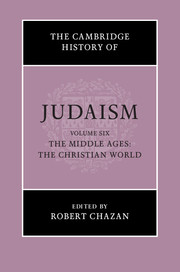Summary
This chapter traces the history and methods of talmudic interpretation in medieval Europe from the eleventh through fifteenth centuries. It begins with the transition from the Moslem orbit in the east to north Africa, Spain and Italy, and highlights the work of Rabbenu Hanan’el of Kairwan, Isaac Alfasi (Rif) and members of the Qalonymus family in northern Italy, along with Nathan ben Yehi’el of Rome, author of the lexicon Sefer ha-‘Arukh. Moving to the Rhineland, the academies at Mainz and Worms and their distinct methodologies are discussed, along with leading teachers such as Rabbenu Gershom and his students, several of whom became the teachers of Rashi. The nature of Rashi’s talmudic commentaries is discussed at some length, with special emphasis on his uncanny ability to lead a student of the Talmud through the text not by offering paraphrases, but rather by helping the student to interpret the text himself. In order to provide the reader with the clearest commentary possible, Rashi generally eschews a discussion of halakhic conclusions, and is unafraid to interpret similar talmudic pericopes differently, according to the best interpretation available on the basis of each local context. Rashi’s pathway through the Talmud enabled his students and descendants in northern France, and their contemporaries in Germany, to develop the Tosafist method of close textual clarification followed by dialectical comparisons and resolutions aimed at conflating the Talmud in a way that united its disparate parts and provided proper halakhic guidance as well. The transition of German Jewry following the First Crusade meant that while the earliest Tosafists, Isaac b. Asher (Riba) of Speyer and Eliezer b. Nathan (Raban) of Mainz, hailed from the Rhineland, a new center in northern France, led by Rashi’s grandson, Rabbenu Tam and his students, quickly became dominant during the twelfth century. The shift in interpretational methodologies among Jewish scholars in this period may be correlated with a somewhat earlier shift within the Christian world from monastic study to the teachings of the masters in the cathedral schools. At the same time, talmudic studies in northern Spain become revitalized in the late twelfth century in Toledo, following the Almohade persecutions in the south and the advances of the Reconquista, in the presence of Meir Abulfaia (Ramah). In addition, the center of talmudic studies in Provence (especially within Lunel and Narbonne) sees the flourishing of several important figures in the late twelfth century, most notably Zerahyah ha-Levi (Razah), author of the Sefer ha-Ma’or to Alfasi’s Halakhot, and Abraham b. David (Rabad) of Posquieres, who commented extensively on the Talmud (even though many of these commentaries are no longer extant), in addition to his glosses to Maimonides’ Mishneh Torah. In the transition from the twelfth century to the thirteenth, material and methods from the Tosafists in northern Europe made their way through Provence in northern Spain, greatly influencing the leading talmudists there throughout the thirteenth century, including Nahmanides, his cousin Rabbenu Yonah of Gerona, and his students in Barcelona, Solomon ibn Adret (Rashba) and Aharon ha-Levi (Ra’ah), all of whom composed lengthy talmudic hiddushim (novellae). At the same time, the genre of halakhic works which had been a staple in the Sefardic orbit since the days of the Geonim and Maimonides now began to have an important place in the north, leading to the production of such works by the middle of the century as Sefer Mizvot Gadol by Moses of Coucy and Sefer Or Zarua’ by Isaac b. Moses of Vienna. Asher b. Yehi’el (d. c. 1325) studied in Germany with one of the last Tosafists, Meir of Rothenburg, before fleeing Germany in the early years of the fourteenth century for Toledo, where he taught for another quarter century. Rosh’s corpus brings together the talmudic methodologies of northern and southern Europe in important ways. Although somewhat more insular, Provencal talmudic interpretation during the thirteenth century proceeds apace, culminating with the monumental work of Menahem Meiri of Perpignan (d. 1316) in his Beit ha-Behirah. Although the late middle ages is a period of persecution in both northern and southern Europe, Spanish talmudic interpretation during the fourteenth century is not without new developments, including the work of Isaac Campanton of Castile who sought to blend talmudic interpretation and philosophical rationalism. And late medieval Ashkenaz boasts several leading figures as well, including Jacob Molin (Maharil), Israel Isserlein, and Jacob Weil. This essay moves well beyond the several most important or best-known scholars and works, and attempts to weave together a comprehensive synthesis of all of those figures (and their literary achievements) who played a role in furthering medieval talmudic interpretation.



